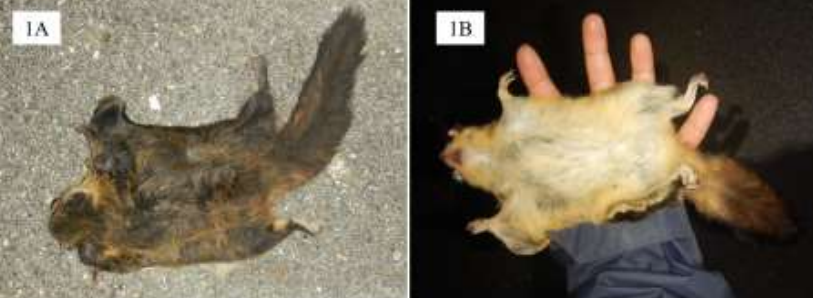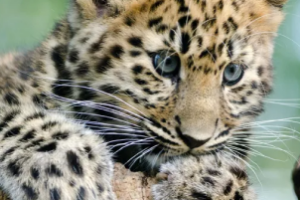
First record of a roadkill hairy-footed flying squirrel Belomys pearsonii (Gray, 1842) from Arunachal Pradesh, India
- Posted by lsetdev
- Date April 2, 2024
E-ISSN: 2708-0021
P-ISSN: 2708-0013
www.actajournal.com
AEZ 2022; 3(1): 12-14
Received: 03-11-2021
Accepted: 11-12-2021
Soham Mukherjee
a) NAJA India, Centre for Wildlife Biology & Research, Ahmedabad, Gujarat, India
b) Life Science Education Trust, Bangalore,Karnataka, India
Mahesh Mhangore
Wild India Expeditions, Bangalore, Karnataka, India
Corresponding Author:
Soham Mukherjee
a) NAJA India, Centre for Wildlife Biology & Research, Ahmedabad, Gujarat, India
b) Life Science Education Trust, Bangalore, Karnataka, India
Soham Mukherjee and Mahesh Mhangore
DOI: https://doi.org/10.33545/27080013.2022.v3.i1a.56
Abstract
Ten of the 13 flying squirrel species are threatened with extinction due to habitat loss, degradation, and hunting in eastern India. Arunachal Pradesh’s rapidly expanding transportation infrastructure is a new emerging threat to this species and possibly others. An adult roadkill specimen of hairy-footed flying squirrel was found in East Kameng district, Arunachal Pradesh, India. This is the first record of a hairyfooted flying squirrel roadkill. Roadkill surveys frequently give ecological, and sometimes, morphological information otherwise unavailable. Detailed research on wildlife and its relationship to roadway infrastructure in biodiverse areas such as Arunachal Pradesh’s forests can aid in the development of efficient mitigation measures.
Keywords: Flying squirrel, roadkill, human-wildlife conflict
Introduction
Several species of squirrels are capable of gliding and are commonly referred to as flying squirrels [1]. Flying squirrels are one of the world’s lesser-known mammals. Due to their crepuscular and cryptic habits, research on these species is limited and irregular. In India, there are a total of 13 species of flying squirrels. The eastern region of the country has the most species (n = 10), followed by three in the northern part, two in the southern part, and one in the western part. Flying squirrels are an essential component of the ecological system, as they aid in seed dispersal [2]. All species, however, are threatened with extinction as a result of habitat loss, degradation, and hunting [3]. In India, the hairy-footed flying squirrel (Belomys pearsonii) is distributed in Arunachal Pradesh, Manipur, Mizoram, Nagaland, Sikkim and West Bengal [4], and prefers temperate and subtropical dry deciduous woods, particularly dense regions of broad leaf forests [5]. Threats to this species include habitat degradation due to changes in land use patterns for agricultural purposes, and hunting for local consumption [5] and sport [6]. A new emerging threat to this species, and possibly others, is the state of Arunachal Pradesh’s aggressively developing transportation infrastructure. It is well established that traffic-congested roads impede animal movement across landscapes, particularly for many long-range, large mammalian species [7, 8], but its impact on smaller wildlife goes underreported [9]. Roads are the second leading cause of anthropogenic mortality for numerous species worldwide, after legal harvesting [10]
.
Materials and methods
Roadkill surveys were conducted on 15 km of road on either side of Leporiang village from 15th May to 22nd May 2019, with emphasis on herpetofauna. Species observed on the survey route were identified and classified as either dead or alive. Each observation included the date, GPS coordinates, and species or the most detailed degree of identification achievable for severely damaged specimens. Each day, the survey started at 20:00 h and ended at 20:30h, followed by a 15-minute break and a return on the same route starting at 20:45 h and ending at 21:15 h.
Results and Discussion
On 20th May 2019, a roadkill specimen of an adult hairy-footed flying squirrel (Fig 1) was found at 21:00 h outside the Pakke Tiger Reserve on Itakhola-Seijusa Road in East Kameng district of Arunachal Pradesh, India. Acta Entomology and Zoology http://www.actajournal.com.
This was an opportunistic observation made while conducting roadkill surveys for a herpetofaunal research project. The species was identified based on its morphological characters – dorsal surface was dark, grizzled in rufous-brown with pale tips, dorsal hair was ashy at the base and dark at the tip, with a pale rufous coloration, dark brown colour above the parachute, rufous colour on the underside of the parachute (Fig 1A), white silky fur on lower body (Fig 1B), dark brown round ears with a tuft of long hairs covering them, pale fur on feet, and rufous-brown tail with a black tip [3, 11]. Further, the identification was validated via community-supported ID system on iNaturalist website (photo 74152985, photo 74153022).
This is the first observation of a hairy-footed flying squirrel reported for a ‘roadkill’ mortality, and second flying squirrel species from India after the Indian giant flying squirrel (Petaurista philippensis) [12]. The hairy-footed flying squirrel is typically found in trees between 5 and 10 m in height, and has been recorded to descend to the shrub layer at 1.4 m but never reported to ascend to the canopy layer at 10 m and higher [13]. We hypothesise that this species exhibits routine shrub layer movement, which requires further research to confirm. Roadkill surveys frequently provide ecological information that may not be possible otherwise. Additionally, they can provide critical morphological data about nocturnal species that are otherwise only observable with a quick glance.
Conclusion
Human population growth has pushed anthropogenic pressures into wildlife habitats, and wildlife-vehicle collisions are a major source of high mortality rates for many wildlife species [14]. It is essential to comprehend and quantify the direct consequences of roads on wildlife, namely the mortality of animals caused by roadways. Estimating the total number of animals killed on roads and the population implications is crucial, but so is using data from wildlife-vehicle collisions to study other elements of ecology [14], especially for secretive species living in dense forests. Focused research on wildlife and its relationship with roadway infrastructure in biodiverse regions like Arunachal Pradesh’s deep forests can help establish effective mitigation measures. Use of citizen science has been an effective means globally [15], and such programs should be promoted in the region.
Acknowledgements
We would like to thank Mr. Nabam Radhe for helping with the logistics of survey.
References
1. Thorington Jr. RW, Pitassy D, Jansa SA. Phylogenies of flying squirrels (Pteromyinae). Journal of Mammalian Evolution. 2002;9:99-135. https://doi.org/10.1023/A:1021335912016
2. Nandini R, Parthasarathy N. Food Habits of the Indian Giant Flying Squirrel (Petaurista philippensis) in a Rain Forest Fragment, Western Ghats. J Mammal. 2008;89:1550-1556. https://doi.org/10.1644/08- MAMM-A-063.1
3. Koli VK. Biology and Conservation Status of Flying Squirrels (Pteromyini, Sciuridae, Rodentia) in India: An Update and Review. Proc Zool Soc. 2016;69:9-21. https://doi.org/10.1007/s12595-015-0141-z
4. Sharma G, Kamalakannan M, Venkataraman K. A=Checklist of Mammals of India with their distribution and conservation status. Zoological Survey of India, Kolkata, India, 2015.
5. Molur S, Srinivasulu C, Srinivasulu B, et al. Conservation Assessment & Management Plan (C.A.M.P.) Workshop Report, 2005, 612.
6. Mishra C, Madhusudan MD, Datta A. Mammals of the high altitudes of western Arunachal Pradesh, eastern Himalaya: an assessment of threats and conservation needs. Oryx. 2006;40:29-35. https://doi.org/10.1017/S0030605306000032
7. Blom A, Zalinge van R, Heitkönig IMA, Prins HHT. Factors influencing the distribution of large mammals within a protected central African forest. Oryx. 2005;39:381-388. https://doi.org/10.1017/S0030605305001080
8. Kerley LL, Goodrich JM, Miquelle DG, et al. Effects of Roads and Human Disturbance on Amur Tigers. Conservation Biology. 2002;16:97-108. https://doi.org/10.1046/j.1523-1739.2002.99290.x
9. Glista DJ. Vertebrate Road Mortality Predominantly Impacts Amphibians. Herpetological Conservation and Biology, 2007, 11.
10. Hill JE, DeVault TL, Belant JL. Cause‐specific mortality of the world’s terrestrial vertebrates. Global Ecol Biogeogr. 2019;28:680–689. https://doi.org/10.1111/geb.12881
11. Menon V. Indian mammals: a field guide. HachetteIndia, Gurgaon, 2014.
12. Arockianathan S. Road kill of Indian giant flying squirrel (Petaurista philippensis) in Coonoor to Mettupalayam Highway, The Nilgiris. International Research Journal of Natural and Applied Sciences. 2014;1:10-14.
13. Lee P-F. Distribution of the hairy-footed flying squirrel (Belomys pearsonii) in Taiwan, a GIS approach. Acta Zoologica Taiwanica. 1998;8:81-92.
14. Schwartz ALW, Shilling FM, Perkins SE. The value of monitoring wildlife roadkill. Eur J Wildl Res. 2020;66:18. https://doi.org/10.1007/s10344-019-1357-4
15. Shilling F, Perkins SE, Collinson W. Wildlife/roadkill observation and reporting systems. Handbook of road ecology, 2015, 492-501.
Previous post
Successful treatment of Otodectes cynotis infestation in domestic African pygmy hedgehogs (Atelerix albiventris)
You may also like

Psychologists investigate meerkats’ response to human emotions



